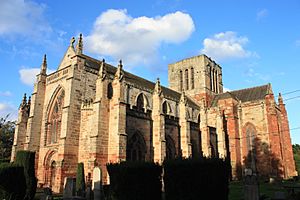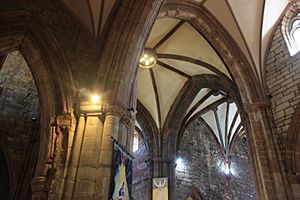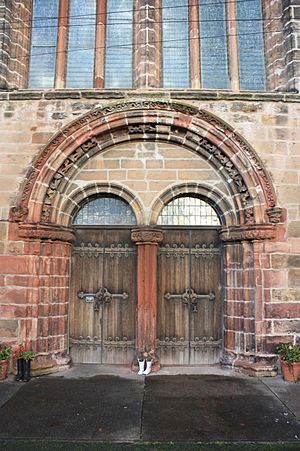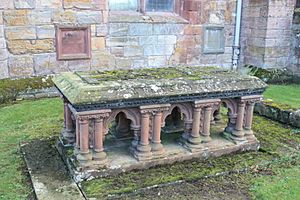St Mary's Collegiate Church, Haddington facts for kids
The Collegiate Church of St Mary the Virgin is a very old and important church in Haddington, East Lothian, Scotland. It belongs to the Church of Scotland. People started building this church way back in 1380, and it has been changed and rebuilt many times since then. It's the longest church in Scotland, stretching about 62.8 meters (206 feet) from one end to the other! It's built in an early Gothic style, which means it has tall, pointed arches and large windows.
Contents
What Makes St Mary's Church Special?
This church is shaped like a cross when you look at it from above. It stands in a big open churchyard, a little way from the town center. The church is so large that it looks like it could be a cathedral. Its design is very consistent, meaning it looks like it was built following one clear plan from the start.
Over the centuries, parts of the church were damaged, especially in the 1500s. But the main part of the church (the nave) and the tower were fixed up so people could use them again. The whole church got a big makeover in the 1970s to make it look its best.
The Choir Area
The choir is the part of the church where the singers or clergy sit. It has aisles on the sides and is divided into four sections by strong supports called buttresses. These buttresses have fancy tops, some with gables (pointed roofs) and some with pinnacles (small towers). The windows in between have simple, curvy designs.
At the very east end of the choir, there's a large window built in 1877. It has four sections and beautiful designs. Look closely, and you might spot a carving of an angel playing the bagpipe! On the north side of the choir, there's an old sacristy (a room for church items) that is now a special chapel and a burial place for the Maitland family. It's dedicated to the Three Kings.
The Tower and Side Sections (Transepts)
The transepts are the "arms" of the cross shape of the church. They don't have aisles. The windows at the ends of these sections are tall with three lights (sections) and designs above them. The north transept now has modern toilets and stairs leading to a gallery.
The south transept has a memorial for George Seton and a beautiful stained glass window. This window was designed by Edward Burne-Jones and was given to the church by the Victoria and Albert Museum during the restoration. To the east of the north transept is the Lauderdale Aisle, a small chapel that remembers John Maitland, 1st Lord Maitland of Thirlestane and other members of the Maitland family.
A spiral staircase in the north transept leads up to the tower. The tower is shaped like a cube and has three tall, narrow windows on each side. There are also small statues in niches next to the windows. The top of the tower has decorative carvings and gargoyles. It looks like there were plans to build a fancy crown-shaped spire on top, similar to those on St. Giles Cathedral in Edinburgh. We don't know if this spire was ever actually built.
The nave is the main part of the church where the congregation sits. It's similar to the choir, with four sections on the north and south sides, supported by buttresses. However, the windows here are like those in the transepts. In 1811, the side aisles of the nave were made taller by about 10 feet and finished with castle-like decorations and pinnacles.
The front of the church, on the west side, has a very large window divided into six main sections. Below this window is the main door. It has a round arch and is divided into two by a central pillar. This pillar has a carving that shows symbols related to the Arma Christi (the instruments of Christ's Passion).
Inside the Church
The inside of St Mary's Church is famous for its amazing sexpartite vaulting on the ceiling. This means the ceiling is made of six-part arched sections. The pulpit (where the minister preaches) and the font (where baptisms happen) were both designed by a sculptor named William Birnie Rhind in 1891.
In the north choir aisle, you can see an old sculpture of Haddington's town crest. It was found during the 1970s restoration. On the east wall of the south transept, there's a memorial to William Seton, who was the Provost (like a mayor) of Haddington in 1682.
In the late 1980s, a new pipe organ was ordered and installed in 1990 in the north transept. The church tower had been silent since 1548, when the English army took away its three bells. But in 1999, the church got a new set of eight bells! These bells were originally made in 1911 to celebrate the coronation of King George V. They were installed between March and May 1999 and were officially dedicated on June 6, 1999.
Beautiful Stained Glass Windows
St Mary's Church has many beautiful stained glass windows, mostly from the late 1800s and early 1900s. Here are some of them:
- The Sepulchre, by Clayton and Bell, 1893, on the south wall.
- Vision of St John the Divine, by Ballantyne Brothers, 1893, on the south wall.
- Christ and the Woman of Samaria, by Edward Burne-Jones, 1895, on the south wall (dedicated to Rev John Brown).
- The Good Woman, by Ballantyne Brothers, 1934, on the south wall.
- The Crucifixion with the Virgin and St John, by Edward Burne-Jones, 1877, in the south transept.
- St Margaret and St Helen, by Sax Shaw, 1979, in the south transept.
- Divine Wisdom, by William Wilson, 1945, on the north wall.
- The Herald Angel appears to the Shepherds, by Ballantyne Brothers, around 1893, on the north wall.
- Christ the Good Shepherd, by Ballantyne Brothers, 1893, on the north wall.
- Christ and the Woman of Samaria, by Ballantyne Brothers/Gardiner, 1893, on the north wall (in memory of Rev Patrick Wilkie).
- The Ascension, by Ballantyne Brothers, 1931, in the upper gallery south.
- Christ and the Sea of Galilee, by Ballantyne Brothers, 1906, in the main west window.
- Gethsemane and Emmaus, by Ballantyne Brothers, 1920, in the upper gallery north.
A Look at St Mary's History
Early Christianity in Haddington
Haddington was a very important town in Scotland during the High Middle Ages (around 1000-1300 AD). It was one of the first towns in Scotland to be given a special charter by the king. Records show that a church existed in Haddington as early as 1139. King David I of Scotland gave the monks of St Andrews Cathedral Priory some land and money from the church. This early church was probably built where the choir of the current church stands today.
Later, in the late 1100s, a large Abbey was founded in Haddington by Ada de Warenne, a countess. This Abbey was for a group of Cistercian Nuns. Besides these nuns, there were also other religious groups in Haddington, like the Franciscans and Dominicans. There was even a place for travelers (a hospitium) and a special house for people with leprosy, which is now a housing estate called St Lawrence.
The "Burnt Candlemas" Event
Because Haddington was so important, it was attacked and burned twice by the English in the 1200s. Once in 1216 by King John, King of England, and again in 1246 by his son, King Henry III of England.
In early 1356, King Edward III of England invaded Scotland. This event became known as the "Burnt Candlemas." Edward had come north to take back a town called Berwick-upon-Tweed, which the Scots had captured. After he succeeded, he stayed in Roxburgh for the winter. In February 1356, Edward's army crossed the Lammermuir Hills. To get revenge for Berwick, he spent ten days in Haddington, where his army destroyed most of the buildings, including the Franciscan Lamp of Lothian. His army also burned other towns in Lothian, including Edinburgh.
John Knox and the Reformation
John Knox, a very famous Scottish reformer, is thought to have been born in Giffordgate, a place across the River Tyne from St Mary's, around 1514. He trained to be a priest in St Mary's, but he never became the minister there. Instead, he worked as a notary and later as a tutor for wealthy families near Haddington. These families supported another reformer, George Wishart. Knox became a bodyguard for Wishart as he traveled around the Lothians.
In January 1547, Wishart preached two services in St Mary's, with Knox standing guard below the pulpit, holding a large two-handed sword. There's no clear record of Knox himself preaching in St Mary's, but since he was ordained there and received money from the church in Haddington, it's very likely he was involved.
Building the Kirk o' St Mary
By 1380, the people of Haddington had recovered enough from the attacks to start building a new church. The building of St Mary's Church took almost a century! It was officially dedicated around 1410 by Henry Wardlaw, the Bishop of Saint Andrews. The main structure was finished in 1462. At that time, the prior of Saint Andrew's even promised a large sum of money (£100) to help decorate the choir.
Church Leaders (Ministry)
The Reverend Alison McDonald became the minister of St Mary's Church in July 2019. She took over after the previous minister, the Reverend Jennifer Macrae, passed away in March 2018.
Notable People Buried Here
Many important people are buried at St Mary's Church, including:
- Jane Welsh Carlyle (1801–1866), inside the church.
- Rev John Brown (1722–1787).
- Very Rev John Cook DD (1807–1874), who was a leader of the Church of Scotland in 1866.
- Sir Robert Sinclair, 9th Baronet (1820–1899), inside the church.
- John Maitland, 1st Lord Maitland of Thirlestane (1537–1595).
- John Maitland, 1st Earl of Lauderdale (died 1645).
- John Maitland, 1st Duke of Lauderdale (1616–1682).
- James Maitland, 8th Earl of Lauderdale (1759–1839).
- Francis Wemyss-Charteris, Lord Elcho (1749–1808).
- Mary Davidson RSW (1855–1950), an artist.
- Col Sir David Davidson KCB (1859–1956).
- Robert Buchan (artist) (1756–1837).
- Rev Dr George Dunbar (died 1711).
- John Pettigrew Croal (1852–1932), who was the editor of The Scotsman newspaper from 1905 to 1923.
- The Earls of Wemyss.
- Francis Farquharson (architect) (1805–1878) and his architect sons John and Robert.
- Dr Archibald Todrick (1912–1992), a pharmacologist.
- A. A. Scot Skirving FRSE (1868–1930), a surgeon.
- George Young V.S. (died 1920), who was the Provost of Haddington from 1911 to 1918.
See also








